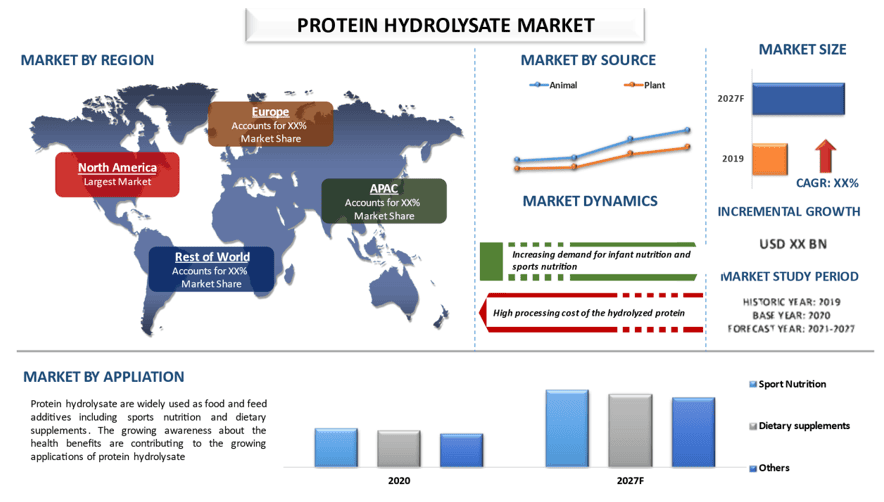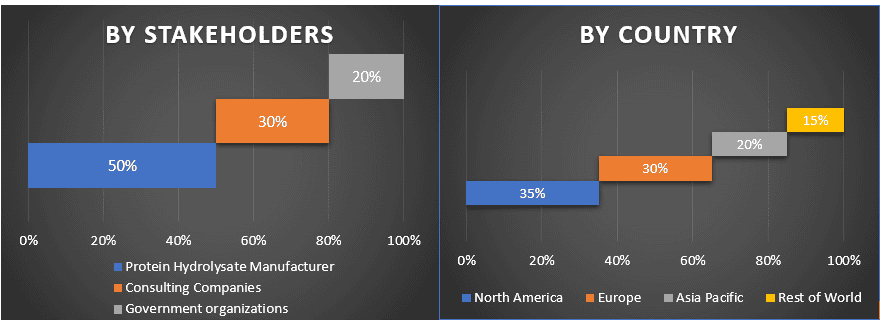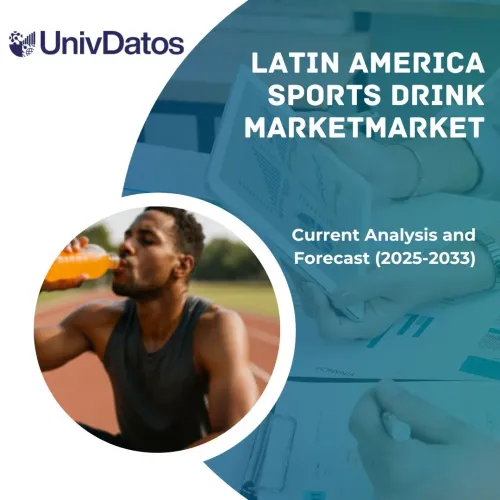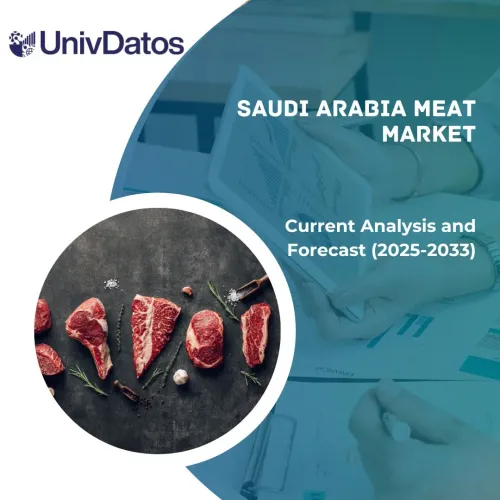- Home
- About Us
- Industry
- Services
- Reading
- Contact Us
Protein Hydrolysate Market: Current Analysis and Forecast (2021-2027)
Emphasis on Source (Plant, Anima); Form (Dry, Liquid); Application (Sports Nutrition, Dietary Supplements, Others); Process (Enzymatic Hydrolysis, Acid & Alkaline Hydrolysis); Region/Country

Global Protein Hydrolysate is Expected to Display an Elevated CAGR of ~8% over the forecast period (2021-2027)
The demand for protein hydrolysate across the globe is promulgating on account of the rising consumer awareness about the nutrient’s insufficiency due to improper food consumption, an emerging number of malnutrition suffered people, etc. As per a study by Oregon State University, about 75% of the US population (ages ≥1 year) do not consume the recommended intake of fruit, and more than 80% do not consume the recommended intake of vegetables. In addition, nearly 10% of the U.S. population has nutrition deficiencies. 10.5% population has Vitamin B6 deficiency, while 8.1% have vitamin D deficiency, as revealed by the Centers for Disease Control and Prevention. Furthermore, there was an 8.9% percentage of undernourished people in Greenland in 2019, As revealed by the Food and Agriculture Organization of the United States,
Moreover, rising lactose intolerance among consumers is one of the key factors that are contributing to the growing demand for protein products; therefore, surging demand for protein hydrolysate. According to the National Digestive Diseases Information Clearinghouse, some 30 million to 50 million Americans are lactose intolerant, including up to 75% of African Americans and American Indians and 90% of Asian Americans.
Also, the shifting trend from animal-based protein to plant protein is propelling the growth of the protein hydrolysates. As per the PlantProteins.co report, 6% of U.S. consumers eat a vegan diet, up from just 1% in 2014. This diet is higher in fiber and lower in cholesterol and fat than an omnivorous diet, and it scores higher on the Healthy Eating Index Trusted Source.
Global and Regional Per Capita Food Consumption (Kcal Per Capita Per Day)

AMCO Proteins, Arla Foods Ingredients Group P/S, Griffith Foods Inc., Kerry Inc., Tate & Lyle PLC, Royal DSM N.V., Nestle S.A, Glanbia PLC, FrieslandCampina, Classic Organic Chemicals, etc., are some of the prominent players operating in the Protein Hydrolysate market. Several M&As along with partnerships have been undertaken by these players to facilitate customers with innovative products.
Insights Presented in the Report
“Amongst source, plant segment to grab considerable market share”
Based on the source, the market is fragmented in plant and animal. The animal segment grabbed XX% market share in 2020 and dominated the market. The demand for animal protein hydrolysates is higher as compared to plant-based hydrolysates owing to the presence of high protein content in animal-based sources as compared to their counterparts. However, the growing shift towards veganism would proliferate the demand for plant-based protein hydrolysate
“Amongst form, dry segment dominated the market in 2020”
Based on the form, the market is fragmented into dry and liquid. The dry segment grabbed the major market share and dominated the market. The increasing R&D has resulted in the advancements in the biotechnology and microbiology research activities, which has resulted in the production of the enhanced dry form of plant-based protein ingredients
“Amongst application, sports nutrition segment to grab considerable market share”
Based on the application, the market is fragmented Sports Nutrition, dietary supplements, Others. The sports nutrition segment grabbed the XX% market share in 2020. However, the dietary supplements segment would witness a considerable CAGR in the forthcoming years
“Amongst process, enzymatic hydrolysis, segment to grab considerable market share”
Based on the process, the market is fragmented into Enzymatic Hydrolysis, and Acid & Alkaline Hydrolysis. The enzymatic hydrolysis segment grabbed the XX% market share in 2020. However, the Acid & Alkaline Hydrolysis segment would witness a considerable CAGR in the forthcoming years
“North America represents one of the largest markets of Protein Hydrolysate market”
For a better understanding of the market adoption of the Protein Hydrolysate market, the market is analyzed based on its worldwide presence in the countries such as North America (the United States and Canada), Europe (Germany, France, Italy, Spain, United Kingdom, and Rest of Europe), Asia-Pacific (China, Japan, India, Australia, and Rest of APAC), and Rest of World. North America region grabbed XX% market for the Protein Hydrolysate Market industry and generated revenue of USD XX Million in 2020. However, the Asia-Pacific region would witness the highest CAGR during the forthcoming years
Reasons to buy this report:
- The study includes market sizing and forecasting analysis validated by authenticated key industry experts
- The report presents a quick review of overall industry performance at one glance
- The report covers an in-depth analysis of prominent industry peers with a primary focus on key business financials, product portfolio, expansion strategies, and recent developments
- Detailed examination of drivers, restraints, key trends, and opportunities prevailing in the industry
- The study comprehensively covers the market across different segments
- Deep dive regional level analysis of the industry
Customization Options:
The Protein Hydrolysate market can further be customized as per the requirement or any other market segment. Besides this, UMI understands that you may have your own business needs, hence feel free to connect with us to get a report that completely suits your requirements.
Table of Content
Analyzing the historical market, estimation of the current market, and forecasting the future market of the Protein Hydrolysate market were the three major steps undertaken to create and analyze the demand for Protein Hydrolysate across major regions. Exhaustive secondary research was conducted to collect the historical market numbers and estimate the current market size. Secondly, to validate these insights, numerous findings and assumptions were taken into consideration. Moreover, exhaustive primary interviews were also conducted, with industry experts across the value chain of the Protein Hydrolysate market. Post assumption and validation of market numbers through primary interviews, we employed a top-down/ bottom-up approach to forecast the complete market size. Thereafter, market breakdown and data triangulation methods were adopted to estimate and analyze the market size of segments and sub-segments of the industry pertains to. Detailed methodology is explained below:
Seek More Details About Research Methodology
Analysis of Historical Market Size
Step 1: In-Depth Study of Secondary Sources:
A detailed secondary study was conducted to obtain the historical market size of the Protein Hydrolysate through company internal sources such as annual reports & financial statements, performance presentations, press releases, etc., and external sources including journals, news & articles, government publications, competitor publications, sector reports, third-party database, and other credible publications.
Step 2: Market Segmentation:
After obtaining the historical market size of the Protein Hydrolysate market, we conducted a detailed secondary analysis to gather historical market insights and share of source, form, process, and application for major regions. Major segments included in the report are form and application. Further region and country-level analyses were conducted to evaluate the overall adoption of Protein Hydrolysate across the globe.
Step 3: Factor Analysis:
After acquiring the historical market size of different segments and sub-segments, we conducted a detailed factor analysis to estimate the current market size of Protein Hydrolysate. Further, we conducted factor analysis using dependent and independent variables such as the growing health consciousness, rising disposable income, etc., A thorough analysis was conducted for demand and supply-side scenarios considering top partnerships, mergers and acquisitions, business expansion, and product launches in the Protein Hydrolysate industry across the globe.
Current Market Size Estimate & Forecast
Current Market Sizing: Based on actionable insights from the above 3 steps, we arrived at the current market size, key players in the Protein Hydrolysate market, and market shares of the segments. All the required percentage shares split, and market breakdowns were determined using the above-mentioned secondary approach and were verified through primary interviews.
Estimation & Forecasting: For market estimation and forecast, weightage was assigned to different factors including drivers & trends, restraints, and opportunities available for the stakeholders. After analyzing these factors, relevant forecasting techniques i.e. bottom-up/ top-down approach were applied to arrive at the market forecast about 2027 for different segments and subsegments across the major markets globally. The research methodology adopted to estimate the market size encompasses:
- The industry’s market size, in terms of value (US$) and the adoption rate of Protein Hydrolysate across the major markets domestically
- All percentage shares, splits, and breakdowns of market segments and sub-segments
- Key players in the Protein Hydrolysate market in terms of services offered. Also, the growth strategies adopted by these players to compete in the fast-growing market
Market Size and Share Validation
Primary Research: In-depth interviews were conducted with the Key Opinion Leaders (KOLs) including Top Level Executives (CXO/VPs, Sales Head, Marketing Head, Operational Head, Regional Head, Country Head, etc.) across major regions. Primary research findings were then summarized, and statistical analysis was performed to prove the stated hypothesis. Inputs from primary research were consolidated with secondary findings, hence turning information into actionable insights.
Split of Primary Participants in Different Regions

Market Engineering
The data triangulation technique was employed to complete the overall market estimation and to arrive at precise statistical numbers for each segment and sub-segment of the Protein Hydrolysate market. Data was split into several segments sub-segments post studying various parameters and trends in the areas of source, form, process, and application of the Protein Hydrolysate market.
Main Objective of the Protein Hydrolysate Market Study
The current & future market trends of Protein Hydrolysate were pinpointed in the study. Investors can gain strategic insights to base their discretion for investments on the qualitative and quantitative analysis performed in the study. Current and future market trends determined the overall attractiveness of the market at a regional level, providing a platform for the industrial participant to exploit the untapped market to benefit from a first-mover advantage. Other quantitative goals of the studies include:
- Analyze the current and forecast market size of Protein Hydrolysate in terms of value (US$). Also, analyze the current and forecast market size of different segments and sub-segments
- Segments in the study include areas off of source, form, process, and application
- Define and analysis of the regulatory framework for the Protein Hydrolysate industry
- Analyze the value chain involved with the presence of various intermediaries, along with analyzing customer and competitor behaviors of the industry
- Analyze the current and forecast market size of the Protein Hydrolysate market for the major countries
- The major region studied in the report includes North America, Europe, Asia- Pacific, and the Rest of the World.
- Company profiles of the Protein Hydrolysate market and the growth strategies adopted by the market players to sustain in the fast-growing market
Deep dive regional level analysis of the industry
Related Reports
Customers who bought this item also bought










